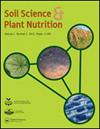基于SWAT的寒气候旱地农业流域土壤流失时空分析——以日本北海道东京都河流域为例
IF 1.8
4区 农林科学
Q3 ENVIRONMENTAL SCIENCES
引用次数: 0
摘要
摘要严重的水土流失既会造成生态系统服务功能的丧失,也会造成河流环境的污染。因此,了解流域尺度土壤流失的时空特征对水土资源的可持续管理至关重要。本研究的主要目的是评估日本北海道东京都河流域(TRW)的水径流和土壤流失的时空变化。假设农用地是侵蚀的主要来源,随着季节的变化而变成光秃秃的土地,特别是在融雪/冻融期间发生了大量的土壤流失,我们使用水土评估工具2012 (SWAT2012)对土壤流失机制进行了量化分析。基于公开数据集的模拟结果表明,农田是水系泥沙负荷的主要来源,占总土壤流失量的86%。耕地比例较高的子流域,特别是坡耕地,土壤流失率较高(241.1 ~ 270.9 Mg km−2 yr−1)。由于强烈的侵蚀和泥泞径流对河流的污染,这些子流域的生产力损失风险更高。土壤流失主要发生在早春(3 ~ 4月)和夏末(8 ~ 10月),分别占全年土壤流失量的36%和45%。10月份因收获造成的植被移除加剧了土壤流失。3月土壤排水受冻土抑制,地表径流量大,土壤流失量大。因此,土壤冻结时的地表径流被认为是土壤流失的重要驱动因素。在95%的预测不确定度中,水系泥沙负荷的估计误差占总绝对误差的26%。造成这种误差的原因可能是高水系泥沙负荷的观测数据缺乏确定性,以及模型在强烈融雪和降雨事件中对水径流的低估。本研究得到了JST SPRING的资助(资助号:JPMJSP2119)。披露声明作者未报告潜在的利益冲突。本研究得到了JST SPRING的支持[授权号:JPMJSP2119]。本文章由计算机程序翻译,如有差异,请以英文原文为准。
Spatiotemporal analysis of soil loss in cold climate upland farming watersheds using SWAT: case study of Tokoro River watershed, Hokkaido, Japan
ABSTRACTSevere soil erosion can cause both loss of ecosystem services and riverine environmental contaminations. Thus, understanding the spatiotemporal characteristics of soil loss at the watershed scale is critical for sustainable management of land and water resources. The primary objective of this study was to estimate the spatiotemporal variation in water runoff and soil loss in the Tokoro River watershed (TRW), Hokkaido, Japan. Assuming that agricultural land, which becomes bare depending on the season, is the main source of erosion and that large soil losses occur especially during the snowmelt/freeze-thaw period, we quantified and analyzed the mechanism of soil loss using the Soil and Water Assessment Tool 2012 (SWAT2012). Simulation results based on a publicly available dataset showed that croplands were the primary source of stream sediment load, contributing to 86% of the total soil loss. Furthermore, the soil loss rate was high (241.1–270.9 Mg km−2 yr−1) in sub-basins with a higher percentage of cropland, especially sloped croplands. These sub-basins had a higher risk of productivity loss due to intense erosion and river contamination by muddy runoff. Soil loss mainly occurred in early spring (March and April) and late summer (August – October), accounting for 36% and 45% of the annual soil loss, respectively. Vegetation removal by harvest exacerbated soil loss in October. In March, soil drainage was suppressed by frozen soil, resulting in high surface runoff and soil loss. Therefore, surface runoff when the soil was frozen was considered an important driver of soil loss. The estimation error of the stream sediment loads out of the 95% prediction uncertainty accounted for 26% of the total absolute error. This error could be attributed a lack of certainty in the observation data of high stream sediment loads and the model’s underestimation of water runoff during intense snowmelt and rainfall events.KEYWORDS: Water erosionSWAT modelfrozen groundsnowmeltagriculture AcknowledgmentsThis research was conducted with a financial support from JST SPRING (Grant Number: JPMJSP2119).Disclosure statementNo potential conflict of interest was reported by the author(s).Additional informationFundingThis work was supported by JST SPRING [Grant Number: JPMJSP2119].
求助全文
通过发布文献求助,成功后即可免费获取论文全文。
去求助
来源期刊

Soil Science and Plant Nutrition
农林科学-农艺学
CiteScore
4.80
自引率
15.00%
发文量
56
审稿时长
18-36 weeks
期刊介绍:
Soil Science and Plant Nutrition is the official English journal of the Japanese Society of Soil Science and Plant Nutrition (JSSSPN), and publishes original research and reviews in soil physics, chemistry and mineralogy; soil biology; plant nutrition; soil genesis, classification and survey; soil fertility; fertilizers and soil amendments; environment; socio cultural soil science. The Journal publishes full length papers, short papers, and reviews.
 求助内容:
求助内容: 应助结果提醒方式:
应助结果提醒方式:


